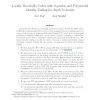290 search results - page 12 / 58 » Pseudorandom Bits for Polynomials |
STOC
2005
ACM
14 years 10 months ago
2005
ACM
In this work we study two, seemingly unrelated, notions. Locally Decodable Codes (LDCs) are codes that allow the recovery of each message bit from a constant number of entries of ...
DSD
2007
IEEE
14 years 4 months ago
2007
IEEE
This paper focuses on numerical function generators (NFGs) based on k-th order polynomial approximations. We show that increasing the polynomial order k reduces significantly the...
DSN
2004
IEEE
14 years 1 months ago
2004
IEEE
Cyclic Redundancy Codes (CRCs) provide a first line of defense against data corruption in many networks. Unfortunately, many commonly used CRC polynomials provide significantly le...
ACNS
2008
Springer
14 years 4 months ago
2008
Springer
The increased functionality of EPC Class1 Gen2 (EPCGen2) is making this standard the de facto specification for inexpensive tags in the RFID industry. EPCGen2 supports only very b...
LATINCRYPT
2010
13 years 8 months ago
2010
Abstract. Misty schemes are classic cryptographic schemes used to construct pseudo-random permutations from 2n bits to 2n bits by using d pseudo-random permutations from n bits to ...

